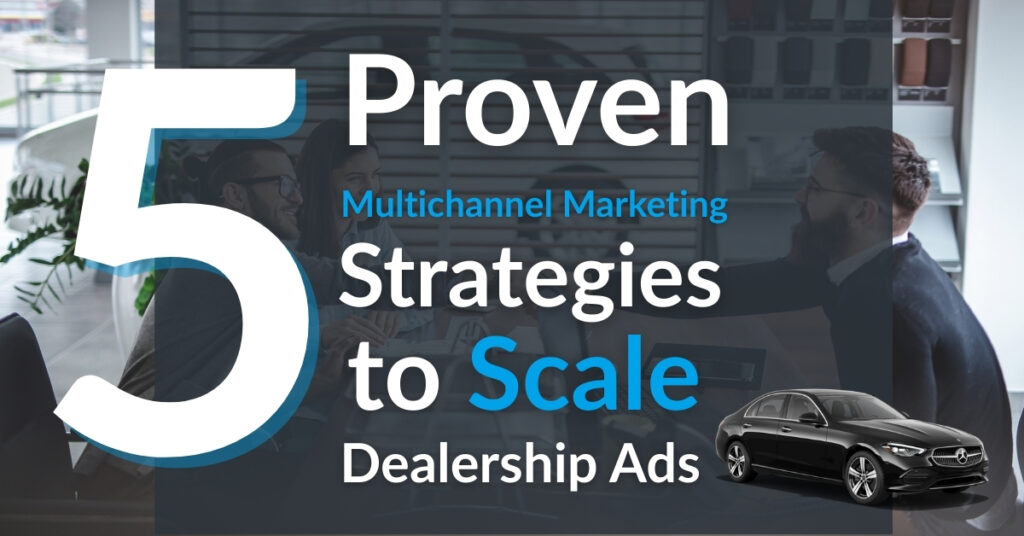Why A Multichannel Marketing Strategy Is a Must for Automotive Agencies
Car buyers aren’t just browsing one platform. They’re everywhere. From swiping through TikTok videos to comparing models on Facebook, their path to purchase spans multiple channels, devices, and moments. For digital marketing agencies managing dealership clients, this shift in behavior demands a more dynamic and strategic approach: multichannel marketing.
And not just any multichannel strategy. A full-funnel, ad-driven, automated approach that captures attention, nurtures intent, and converts interest into car sales across Meta, Snapchat, TikTok, Pinterest, and beyond.
This article will explore the key differences between multichannel and omnichannel marketing, why multichannel marketing is exploding in the automotive space, and how to build full-funnel paid ad campaigns across the platforms that drive results.
We’ll also showcase real campaign examples and reveal how automation tools can help agencies launch faster, scale smarter, and grow monthly recurring revenue (MRR) without adding more hours to the day.
Agencies using tools like BuyerBridge to automate and manage multichannel campaigns aren’t just saving time—they’re scaling rooftops and boosting MRR without increasing workload.
What Is Multichannel Marketing?
Multichannel marketing is the practice of using multiple platforms to engage your audience, meeting them wherever they are in the digital landscape. This blog will be discussing paid social ads specifically. In automotive advertising, this means placing paid social ads across a variety of high-intent, high-engagement channels like Meta (Facebook and Instagram), TikTok, Snapchat, and Pinterest.
Instead of relying on a single platform to reach potential car buyers (like Google VLAs), multichannel marketing opens up multiple entry points. It’s not just about casting a wider net for the sake of ad spend. It’s about strategically positioning your dealer’s message where different types of buyers are spending time and making decisions.
Key Benefits of Multichannel Dealership Ad Strategy
With multichannel marketing, your agency can:
- Maximize exposure by showing up in more digital spaces
- Reach more buyer personas—younger buyers may be on Snapchat and TikTok, while Pinterest users tend to plan purchases with intent
- Control messaging per platform—you might use a storytelling video on TikTok while pushing inventory carousels on Meta
- Diversify ad spend and avoid over-reliance on one platform’s algorithm changes or cost fluctuations
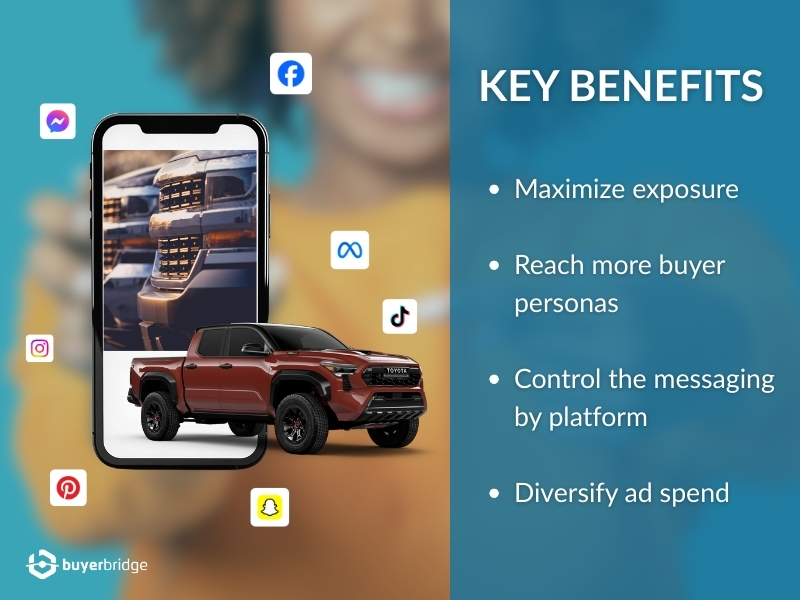
This strategy works especially well for dealers because car shopping is a high-touch process. Buyers are browsing, comparing, saving vehicles, and watching reviews, and they’re doing it across different platforms, often multiple times before submitting a lead.
Why Multichannel Works So Well in Automotive Marketing
Car buyers don’t just browse—they bounce. 75% of auto intenders use at least three social platforms before making a purchase decision. Research also shows buyers are nearly three times more likely to convert after seeing consistent messaging across multiple channels.
Automotive is a high-consideration category that thrives on repetition, retargeting, and relevance.
When agencies show up where their customers are, whether that’s in a vertical video on TikTok or a carousel ad on Facebook, they give their dealership clients a better shot at driving real, measurable results.
Multichannel Marketing vs. Traditional “One-Channel” Thinking
For years, many dealerships relied solely on Facebook ads. And while Facebook still dominates in automotive reach, it no longer works alone. TikTok, Snapchat, and Pinterest have all emerged as valuable parts of the funnel, especially with video formats, shopping integrations, and platform-specific behaviors that push buyers closer to action.
Your role as a marketing partner is to unlock each platform’s unique advantage and stitch together a strategy that works holistically, not just in silos.
Here’s what that might look like:
- Use TikTok Top-of-Funnel video content to spark interest and generate engagement
- Re-engage with Meta Lead Gen Ads to capture form fills or Messenger responses
- Retarget with Pinterest Inventory Ads to bring shoppers back to saved vehicles
- Drive urgency on Snapchat with Stories and swipe-to-chat offers
All of this adds up to a full-funnel, multichannel experience where every platform plays a role in the buyer journey.
How Multichannel Paid Social Aligns With Automotive Buyer Behavior
The average car buyer today:
- Switches devices 3–5 times per day
- Consumes short-form video (TikTok, Reels, Stories) before making buying decisions
- Wants consistent messaging, but not copy-paste ads
- Trusts peer content and real-time relevance over static, one-size-fits-all promotions
So if your dealership clients are only running ads on one platform, they’re missing out, plain and simple. A multichannel strategy ensures you’re showing up across every key step of the funnel and every scroll of the buyer’s day.
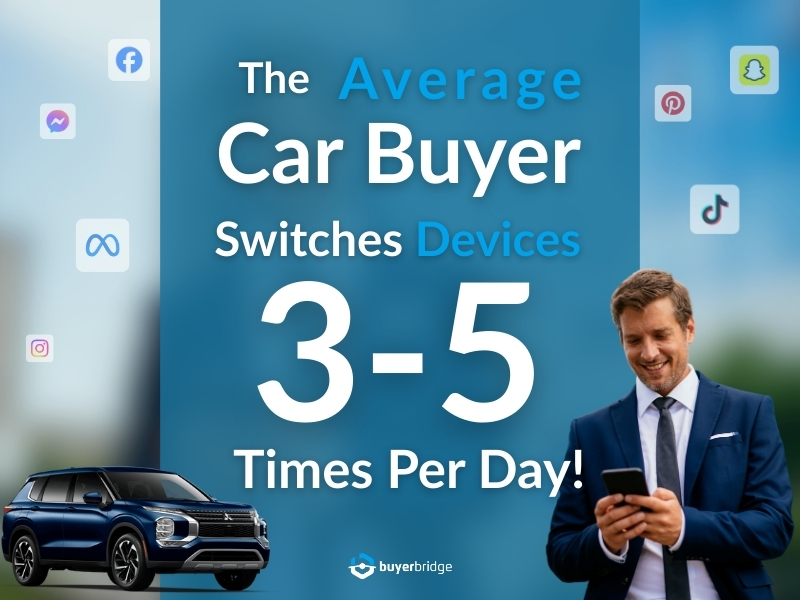
What’s the Difference Between Multichannel and Omnichannel Marketing?
Multichannel and omnichannel marketing are often used interchangeably, but for agencies managing dealership campaigns, the difference matters.
Multichannel Marketing = More Channels but Independent Messaging
In a multichannel marketing strategy, your agency promotes a dealership’s inventory or offers across multiple platforms. like Meta, Pinterest, Snapchat, and TikTok, but each channel may operate independently. The goal is to maximize reach and presence, making sure your client is “everywhere” their buyers might be.
You can tailor creatives to each platform and control spend based on performance.
For example:
- Use dynamic inventory carousels on Facebook to drive VDP clicks
- Launch short-form video test drives on TikTok for awareness
- Run price-drop alerts as swipe-up Stories on Snapchat
- Showcase Saved Pin reminders on Pinterest for retargeting
The messaging might vary slightly by platform, but the focus is channel-specific success.
Omnichannel Marketing = Unified Experience Across Channels
Omnichannel marketing goes a step further. It’s not just about being on every channel—it’s about creating a seamless experience across them.
Think of it as a connected buyer journey, where every touchpoint reinforces the last.
For example:
- A buyer watches a dealership’s TikTok and clicks to learn more
- Later, they see a Facebook retargeting ad for the exact vehicle they browsed
- Then they receive a Messenger follow-up offering a test drive
- After submitting a lead, they’re shown a Pinterest ad showcasing dealership reviews
All of these experiences are orchestrated around the buyer, not the platform. That’s the essence of omnichannel and where marketing automation becomes essential.
TLDR: The Key Difference: Coordination vs. Presence
- Multichannel = multiple platforms, managed independently
- Omnichannel = multiple platforms, coordinated and connected
Both strategies can work, but multichannel is typically the starting point for most agencies, especially when budget, creative resources, or platform maturity vary by client.
The best results often come from a hybrid approach: launch multichannel campaigns, then use automation and CRM integration to turn them into a truly omnichannel experience.
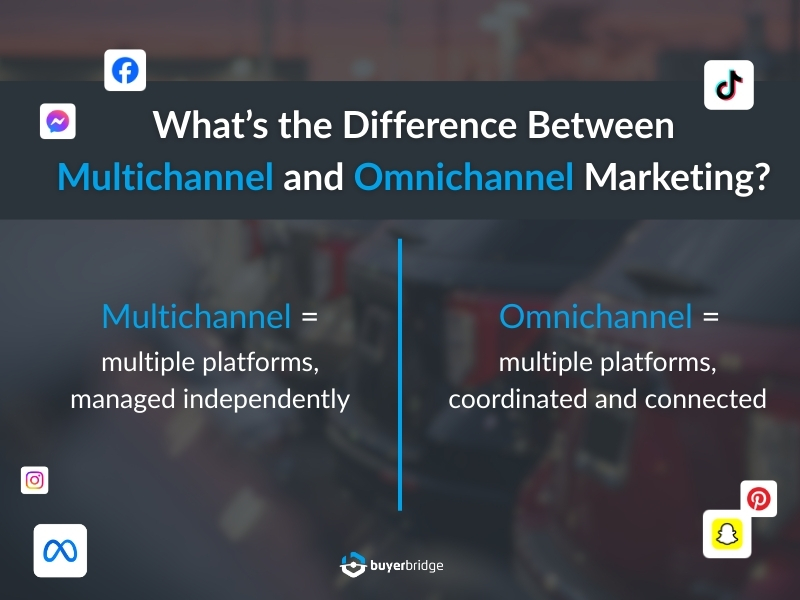
Why Automation Is Essential for Omnichannel Strategies
While multichannel marketing focuses on running ads across many platforms, omnichannel marketing takes it further by connecting all those touchpoints into a single, seamless experience for the shopper. That level of coordination across platforms, formats, audiences, and timing is nearly impossible to manage manually, especially at scale.
That’s where automation becomes a game-changer.
Automation Unifies Messaging Across Platforms
With automation tools, your agency can create a single campaign narrative and ensure it adapts per channel, without duplicating work.
For example:
- You launch a TikTok video campaign for awareness.
- That same theme auto-generates a Pinterest ad with saved pins.
- Facebook and Instagram dynamically pull vehicle inventory to show that model with the same creative angle.
- Snapchat mirrors the message with swipe-up test drive offers.
You get unified storytelling across platforms, with minimal lift from your team.
Automation Powers Real-Time Retargeting
Omnichannel success depends on what happens after the first click.
When a buyer interacts with an ad on one platform (say, watching a full TikTok video), automation can instantly trigger:
- A retargeting ad on Facebook showing that specific vehicle
- A follow-up Pinterest carousel with similar models
- A Messenger chat campaign to book a test drive
Without marketing automation, these follow-ups would require complex manual audience updates and delays. With automation, they happen in near real-time, keeping your dealership client top-of-mind.
Marketing Automation Bridges Offline and Online Activity
Advanced omnichannel tools (like BuyerBridge’s EventFlow) even track offline actions, like test drives and purchases, and feed that data back into your ad platforms.
This allows you to:
- Automatically adjust budgets to focus on top-performing platforms
- Personalize the creative based on real buyer behavior
- Prove ad-to-sale ROI with matchback reporting
Want to make omnichannel strategies scale?
Automation doesn’t just support omnichannel, it makes it possible. If your agency is managing multiple rooftops or OEM programs, platforms like BuyerBridge help you connect the dots across channels and launch faster, without burning out your team.
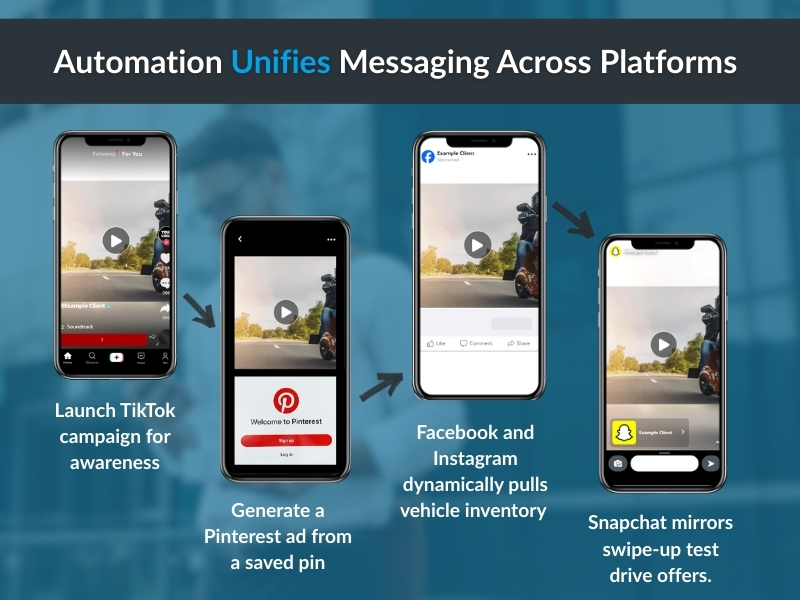
Why Multichannel Marketing Is Getting More Attention in 2025
Multichannel marketing isn’t new, but in 2025, it’s quickly becoming non-negotiable for agencies managing dealership clients trying to keep an edge during tariff-ridden times.
The reason? The landscape has shifted dramatically, and so have buyers demographics.
Today’s car buyers are harder to reach, more selective with their attention, and constantly jumping between platforms, devices, and content formats. The old playbook of “run Facebook ads, wait for leads” just doesn’t cut it anymore. Social media has evolved from a single-channel lead source to a complex, multi-touch ecosystem that spans TikTok, Pinterest, Snapchat, Meta, and Google, and it’s reshaping how shoppers engage with inventory, offers, and dealerships.
At the same time, dealership expectations have skyrocketed. They want more visibility, more value from ad spend, and full-funnel results they can trace back to real sales. And they want all of it faster.
If your agency isn’t building multichannel campaigns with the marketing automation tools to back it, you’re not just losing efficiency. You’re losing competitive edge. And it will catch up to your business. Multichannel/omnichannel marketing in 2025 isn’t a nice-to-have.
It’s how agencies scale, earn MRR, and win more rooftops.
Fragmented Shopper’s Attention = Missed Opportunities
Car shoppers are not loyal to one channel. They bounce between platforms constantly, and if your ad strategy doesn’t meet them there, someone else’s will.
A single-platform campaign might grab attention, but multichannel marketing ensures your client stays visible, relevant, and top-of-mind throughout the entire buyer journey.
More importantly, it keeps your agency adaptable.
If CPMs spike on one platform, or a new format launches (hello, TikTok Spark Ads, Pinterest AIAs including used models, or Snapchat Spotlight), multichannel strategies give you the agility to pivot and optimize on the fly.
Agencies sticking to a “Facebook-only” model are feeling the pressure as lead costs rise and buyer behavior shifts toward video-first channels.
OEM Expectations Are Rising
OEM programs have changed the game. Whether you’re managing Tier III co-op campaigns or customizing national offers for local rooftops, manufacturers are now demanding:
- Cross-channel presence with sales stats, not just impressions or views
- Creative consistency and formatting
- Full-funnel strategies and corresponding reporting
- More video, less static
Some OEMs are even requiring or incentivizing dealers to run across multiple platforms, making multichannel campaign automation a major competitive advantage for agency partners. A multichannel strategy gives your agency the power to meet those expectations—and win bigger contracts in the process.
Full-Funnel Focus Is the New Norm (and more cost-effective)
It’s not just about generating leads anymore. Dealerships expect marketing partners to influence and measure impact at every stage of the buyer journey from discovery to decision.
This is where multichannel marketing shines. Each platform plays a distinct role in the funnel, and with the right campaign mix, you can guide auto shoppers from casual scroll to scheduled test drive.
Here’s what a full-funnel multichannel strategy can look like in action:
Top of Funnel: Drive Awareness and Interest
- TikTok: Launch a branded “Behind the Wheel” video series showing test drives, car features, or quick dealership walkarounds. Use Spark Ads to boost performance using real creators.
- Snapchat: Run Story Ads and Commercials that promote seasonal sales or new model arrivals. Add swipe-ups that lead to your dealership’s TikTok or VDP.
- Pinterest: Pin lifestyle content like “Top SUVs for Family Road Trips” or “Fuel-Efficient Cars for Commuters” linked to relevant inventory.
These upper-funnel tactics build brand recognition, introduce inventory categories, and plant the seed for later remarketing.
Pinterest is especially powerful for mid- and lower-funnel engagement when users are actively researching car purchases, and automation makes it easy to stay relevant. See how agencies are automating Pinterest Inventory Ads to grow faster.
Mid-Funnel: Engage and Re-Engage Shoppers
- Meta (Facebook/Instagram): Use retargeting carousels powered by dynamic inventory to show vehicles shoppers viewed but didn’t act on. Include real-time pricing and availability.
- Pinterest: Serve ads to users who’ve previously pinned or clicked on car-related content. Show similar vehicles or service offers to draw them back.
- Snapchat: Deliver Story retargeting ads featuring price drops, new incentives, or customer reviews.
At this stage, your goal is to bring interested users back into the funnel and nudge them toward taking action, like scheduling a visit or contacting a salesperson.
Bottom of Funnel: Convert and Drive Action
- Meta Lead Ads: Offer low-funnel incentives like “$500 off this weekend only” with pre-filled lead forms. Use Messenger for live sales chats.
- TikTok Ads: Use “Book a Test Drive” CTAs with local targeting. Even better, showcase recent customer handovers to build social proof.
- Pinterest & Snapchat: Promote dealership-specific offers with urgency-based language like “2 left in stock” or “Ends Monday!”
Here, your message is direct: act now. Combining urgency, trust-building content, and easy-to-complete actions makes conversion friction-free.
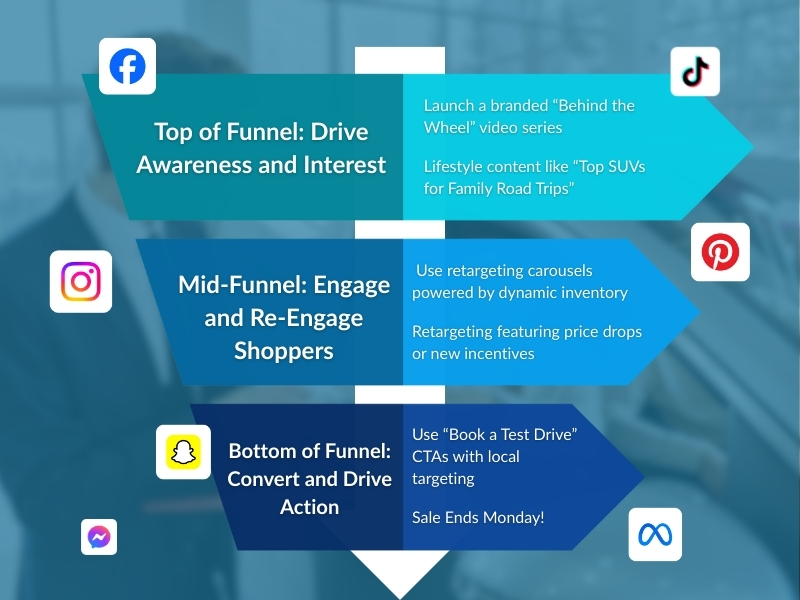
How It All Comes Together
When you execute campaigns across channels like this—strategically, not randomly—you’re building a connected ecosystem that nurtures the buyer all the way through.
Better yet, with omnichannel marketing automation, your agency can:
- Sync messaging across platforms
- Track funnel stage performance
- Identify creative or platform gaps
- Reallocate budget dynamically
- Prove campaign impact with clean attribution
It’s not about throwing the same ad on five platforms. It’s about using each one for its strength and connecting them all.
Snapchat continues to play a huge role in reaching Gen Z and Millennial car shoppers, especially when paired with automated campaigns designed to scale. Here’s how agencies are automating Snapchat ads to capture more in-market buyers.
Multichannel Ad Campaign Examples That Agencies Can Steal and Scale
Want to make multichannel marketing feel less overwhelming and more executable? The good news: you don’t need to start from scratch.
Below are real-world, full-funnel campaign ideas your agency can run across Meta, Snapchat, TikTok, and Pinterest. These aren’t “concepts”—they’re proven templates that drive performance when tailored to dealership goals, inventory, and audience behavior.
Campaign 1: “Weekend Test Drive Push” (Bottom-of-Funnel)
Objective: Drive in-store traffic and booked test drives between Friday and Sunday.
Platforms:
- Meta (Facebook/Instagram): Dynamic ads featuring real-time vehicle inventory with CTA: “Schedule Your Weekend Test Drive.”
- TikTok: Video of a salesperson walking through this weekend’s spotlight vehicle; use countdown stickers for urgency.
- Snapchat: Snap Ads with swipe-to-book or swipe-to-chat. Highlight “only 2 left” offers.
- Pinterest: Retargeting ad showcasing the exact vehicle the user engaged with earlier in the week.
Why It Works: This multichannel campaign hits urgency, relevance, and convenience. TikTok drives attention, Snapchat sparks action, and Meta/Pinterest closes the loop with direct conversions.
Campaign 2: “Tax Refund = Down Payment” (Mid-Funnel)
Objective: Re-engage buyers considering affordability and financing.
Platforms:
- Meta: Instant forms or Messenger campaigns with copy like “Turn Your Refund Into a New Ride.”
- Snapchat: Video ads using refund-themed stickers, paired with zero-down incentives.
- Pinterest: Ad groups targeting financial planning keywords with overlays like “Smart Ways to Use Your Tax Return.”
- TikTok: Quick, relatable skits showing what a refund can get you—cue the “before and after the dealership” transformation trend.
Why It Works: It uses timely relevance + cross-platform targeting to move hesitant buyers forward—perfect for February through April.
Campaign 3: “Model Takeover Week” (Full-Funnel)
Objective: Build awareness and drive conversions for a specific vehicle type—e.g., trucks, hybrids, or SUVs.
Platforms:
- Pinterest: Carousel of lifestyle content like “Best Trucks for Camping Season,” linking to dealership listings.
- Meta: Dynamic inventory ads featuring the highlighted model + video testimonials.
- TikTok: Launch a 3-part series with real owners, dealership staff, or influencers demoing features in real life.
- Snapchat: Geotargeted Story Ads offering local incentives or “build and price” tools.
Why It Works: This creates saturation around a single model, great for dealership co-op incentives or moving volume.
Bonus: Layer Automation on Top for Real Scale
Each of these campaigns can be templated and automated using multichannel marketing automation tools.
That means:
- No rebuilding creative for every platform
- No manually syncing targeting or retargeting lists
- No slow rollouts for new offers
Platforms like BuyerBridge let you save these types of campaigns as reusable Playbooks, so your agency can launch and scale high-performing ads across rooftops, with just a few clicks.
Multichannel Marketing Is the New Agency Advantage
Multichannel marketing isn’t just a trend. It’s a necessity. Car buyers are everywhere, and your agency needs to be, too. Whether you’re driving awareness on TikTok, retargeting on Meta, showcasing inventory on Pinterest, or creating urgency on Snapchat, the key is building a full-funnel, multichannel strategy that works together, not in silos.
But visibility alone won’t scale your agency. Marketing automation is what turns a multichannel strategy into an omnichannel execution. It’s how your team launches faster, manages more rooftops, and drives measurable results without increasing overhead.
Related Reading: How Automation Tools Help You Scale Smarter
Already thinking about how to integrate Playbooks into a broader automation system? We’ve got you covered.
Read our article on Marketing Automation Tools That Launch Social Ad Campaigns Fast for a deeper dive into how automation platforms (like BuyerBridge) support full-funnel success and agency scalability.
Playbooks are your launchpad. Automation tools are your operating system. Together, they drive faster results and bigger returns.
Ready to Launch Smarter?
If you’re ready to cut down setup time, boost performance, and finally scale without stress, it’s time to automate ad strategies with BuyerBridge.
Get more from your campaigns—without doing more work.

